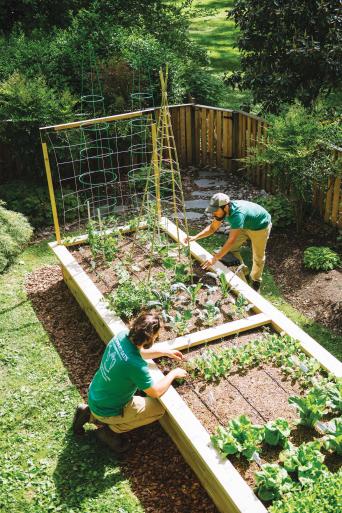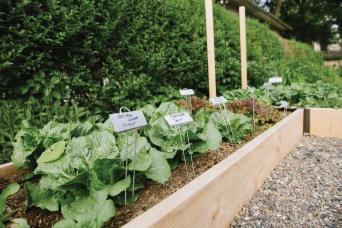
The Why and How of Planning Your Garden Now
Detailed garden planning is usually an activity reserved for the dead of winter, when the cold bleakness cries out for a hopeful diversion. This year is different of course, not only because of our consistent need for hopeful diversions, but also because seeds and plants will likely be scarce and late-arriving due to increased demand and seed companies’ decreased ability to process that demand.
For that reason, or if you find yourself missing connection and relieved of holiday party preparations and exhausting travel schedules, I urge you to dive into your 2021 garden plans early. Kick off the year with a season-long experience that can be shared no matter the distance.
What to Grow
First, create a list of the crops you want in your garden for the whole year. We divide crops into groups by timing: Spring crops are planted or sowed beginning mid-March, and summer crops are planted mid-May. Groups are further divided by how long those crops remain in the garden after planting.
- Herbs — rosemary, sage, and lavender, for example — are planted late spring and remain all season. Some will overwinter if well rooted and protected. We aim to plant them in the landscape or in pots rather than raised beds to leave room for vegetable crops.
- “Quick Spring Crops,” such as lettuce, radish, and bok choy, are ready for harvest within two months, meaning the space they take up in the spring will be open for summer planting.
- “Slow Spring Crops,” such as broccoli, carrots, and peas, will still be maturing when mid-May rolls around, so they’ll take up space in your summer garden before they’re ready for harvest.
- “All-Season Spring Crops,” including kale, collard greens, and swiss chard, can be massively productive through Fall if managed properly.
- Summer is mostly about the “Fruiting Crops,” such as tomatoes, cucumbers, and squash. Descended from warmer parts of the world, these crops are mostly vining, lending themselves to vertical growing, and all are capable of producing yields through October if managed properly.
- Not to be overlooked in the vegetable garden, cut flowers can inspire the same sense of pride and joy. Zinnia, snapdragon, cosmos, and morning glory are summer-planted and will remain productive through most of the season.
Plan Your Summer Garden First
We always start with the summer planting plan for several reasons. First, most people have a clear idea of how many tomatoes, peppers, cucumbers, and beans they want out of their summer garden, and it’s usually enough to overfill the space available. So, finding space for summer selections and paring them down if needed is the first priority.
Second, crop rotation is important. There are fungal and bacterial diseases that correspond to families of crops and will establish themselves in the soil if the same families of crops are grown in the same place year after year. To keep it simple, we look to rotate the “nightshade” or Solanaceae family on a three-year basis. This means we only plant one third of any garden with tomato, pepper, eggplant, tomatillo, husk cherry, or potato. That way, we always have one third of the garden that hasn’t been planted with nightshades in the past two years. With this simplification, all the other crops get passively pushed around in the rotation by default.
After we place the nightshades, we place other plants by their growing habits, working out the vertical support for vining plants and placing shorter plants on the south side for better sun exposure. This includes Slow Spring Crops and All-Season Spring Crops, since they’ll need to hold their space from spring to summer.
Plan Your Spring Garden
Finally, we plan the spring garden. We start with a copy of the summer garden and delete the summer-planted crops. We’re left with the Slow Spring Crops and All-Season Spring Crops that were already in the plan, and we just need to fill in with the Quick Spring Crops. Typically, this leaves you with plenty of room to fill in with lettuces, baby beets, arugula, spinach, sweet turnips, dill, cilantro, and kohlrabi. Don’t hold back! With the mild weather of spring, these crops will transform your palate and mindset around healthy eating. Don’t be intimidated by the size of the harvest either, since home-harvested greens will last an eternity in the fridge.
Interplanting and Reverse Interplanting
Other strategies deserve mention. Interplanting is a great way to use space efficiently. We use it to sneak smaller, shorter-lived crops among larger and longer-lived crops; for example, radishes sowed among lettuce, broccoli, kale, or any other longer-lived spring plant. While lettuce takes a couple months to mature, radishes will be ready in half the time. That means you can harvest mature radishes from between your lettuce just as the lettuce begins to require that soil space and sunlight that the radish was using.
Reverse interplanting is a technique we use in transition from spring to summer. Each week, we harvest and destroy more of a spring crop in a broadening circle around a summer plant to accommodate the summer plant’s growing need for soil resources. We get the best of both worlds and avoid stunting the summer plant by clearing soil space as it’s needed.
At Backyard Eats, our service offerings are shaped by the needs of home gardeners. If you’d like help with your garden plan, we start with a consultation booked online and cover all the essential elements of a successful garden.
Chris Mattingly is the founder of Backyard Eats, a full-service food gardening business with an array of offerings in the greater Philadelphia area. Email him at chris@backyard-eats.com or visit www.backyard-eats.com.

